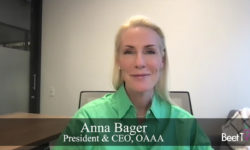It may be in the earliest throes of creation, but Meta is already hoping to entice brands and ad buyers into the metaverse.
The rebooted Facebook owner’s agency relations team is already warming up the ad community.
In this video interview with Beet.TV, Jason Dailey, director, head of agency at Meta, explains a three-staged evolution toward the metaverse, and urges brands to get involved.
‘Powered by ads’
“We really do believe this is going to be one of the biggest opportunities for brands since the creation of the internet,” Dailey says. “It’s going to create new ways to connect with existing and new customers.
“But, just as brands had to figure out the internet, and then they had to figure out this thing called mobile, they’re going to also have to figure out the metaverse.
“The good thing is, for people who are media buyers or planners, for sure, we think that, just as in the internet, free offerings and services are going to be powered by ads. There’s definitely going to be a lot of sponsorship opportunities. You see that today already.”
‘Embodied internet’
So, what is the metaverse? Interpretations vary widely – from being a new metaphor for spatial computing and social engagement, to being a futuristic moniker bandied around by companies enhancing their investor story.
For Meta, which has cornered the term’s prefix with its big October 2021 announcement, it is a collection of experiences.
“I like the definition of the metaverse as an embodied internet and the successor to the mobile internet,” Daily says. “It’s a place where, instead of just passively viewing content, you’re actively engaged and participating in it.
“It’s a collection of spaces and interconnected experiences. Sometimes they expand into three dimensions where you can explore, and create, and share, and be present with people who aren’t in the same physical space as you.”
Metaverse’s timeline
Given the heightened sense of experience and intimacy in a spatial environment, any appearance of advertising and commercial messages in the new-reality environments are likely to need to tread carefully.
Dailey even describes himself as a VR “skeptic” transformed into a convert by the power of social engagement with a spatial dimension that enhances the feeling of proximity, to individuals and events alike.
Now he imagines a three-staged evolution toward the fullest of metaverse experiences:
- Two years – augmented reality – “today, that’s things like product try-ons or filters and masks”.
- Three to five years – mixed-reality experiences … “taking things from your virtual world and bringing them into the physical world” …
- Ten years – fully immersive VR, “where you can have a fully realistic Codec Avatar that you take with you wherever you go. There will be natural user interfaces, fully extensible interoperability.”
Engaging early
How should brands be thinking about the new realm?
Meta’s Dailey is simultaneously engaged in pointing brands back toward the relative simplicity of AR and getting them to think a lot bigger.
“(AR) is where there are the most natural current entry points into the metaverse,” he says. “Everybody has one of these in their pockets, and it’s relatively inexpensive and easy to scale experiences …
“Instead of thinking about what do you want to create in the next quarter or the next five to six weeks, try to be James Cameron. Ask yourself, ‘What would I want to create in the next three to five years?’ and then work your way back from there.
You are watching “Advertising Transformation: What’s Next for Converged TV and Video,” a Beet.TV Virtual Leadership Summit presented by Mediaocean. For more videos, please visit this page.














































